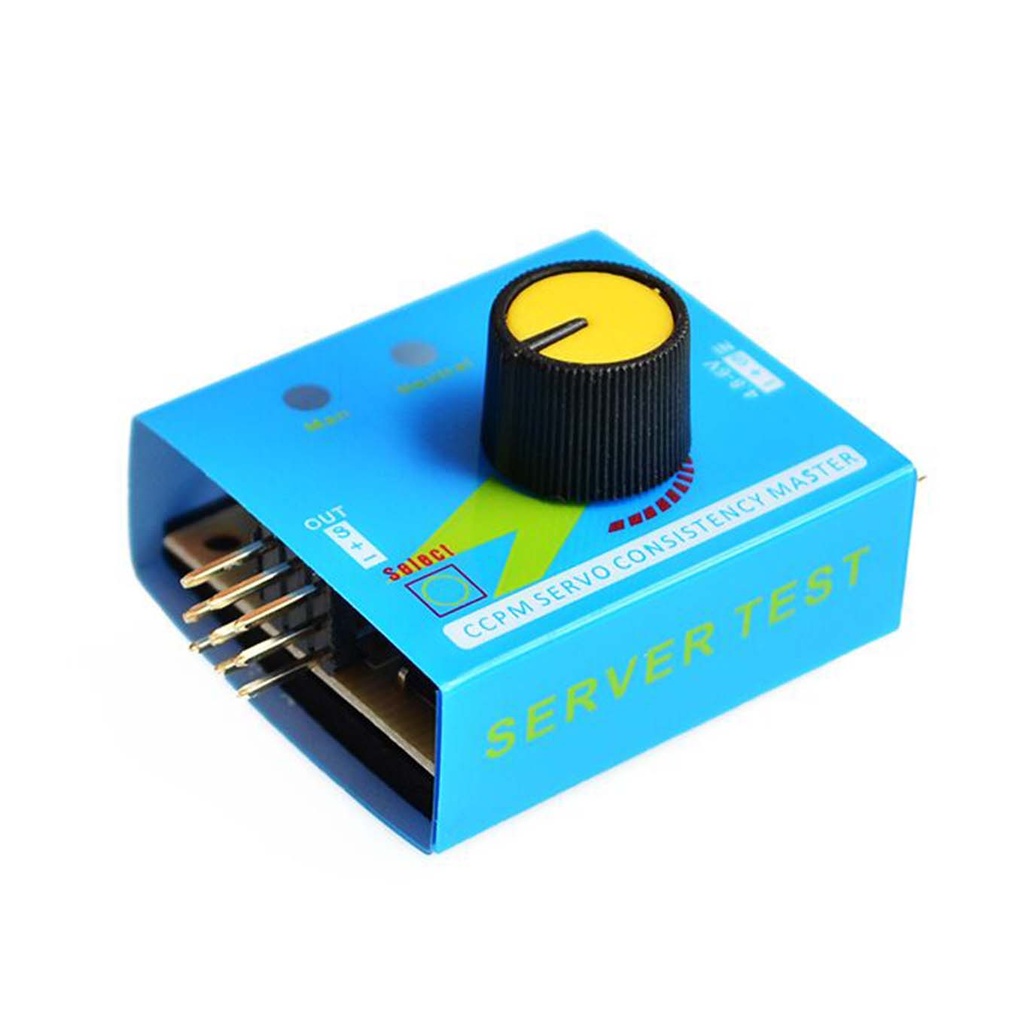Features:
- Test and configure up to 3 servos or ESCs at once
- Knob-controlled steering detection
- Supports CCPM servo consistency checks
- 3 Operating Modes:
- Manual: Turn the knob to test servo speed and reaction
- Neutral: Returns servo to neutral position
- Automatic: Sweeps servo back and forth like a window wiper
- LED indicators for mode and power status
- Voltage consumption: DC 4.8–6V
- Signal Output: 1.5ms ± 0.5ms
- Compact and lightweight: 46×32×23 mm, 8g
Specifications:
| Parameter |
Value |
| Material |
Plastic |
| Operating Voltage |
4.8V – 6V DC |
| Signal Output |
1.5ms ± 0.5ms |
| Output Current |
15mA (at 5V) |
| Dimensions |
46 × 32 × 23 mm |
| Weight |
8g |
| Color |
Blue |
Pinout Description:
- OUT - S: Servo signal outputs (3 columns)
- OUT - +: Servo power lines
- OUT - -: Ground connections
- IN - S: Input signal from receiver or tester
- IN - +: Power input
- IN - -: Ground input
Principle of Operation:
The servo tester operates using an internal microcontroller unit (MCU) that ensures precise timing and control. Users can select between modes via a selector switch and monitor results using onboard LED indicators. The knob allows real-time control and testing of servo response and motor performance.
Testing Modes:
- Manual Mode: Rotate the knob to test servo range and speed
- Neutral Mode: Automatically centers the servo
- Automatic Mode: Cycles the servo like a window wiper
How to Use:
- Connect servos or ESCs to the output terminals
- Connect a 4.8V–6V power supply
- Select desired test mode using the switch
- Use the knob to control movement in Manual mode
- Observe servo behavior via LED indicators and motion
Applications:
- Test and configure servo motors
- Test up to 3 ESCs simultaneously
- CCPM helicopter servo setup
- Install steering boxes and adjust airplane controls
- Evaluate motor performance without using a remote
Alternative Testing Methods:
- Multimeter: Monitor signal voltage response manually
- Arduino: Programmed to generate servo control signals
- Manual Movement: Move servo horn to test physical motion
- Signal Generator: Use pulse generator to simulate input
While alternative methods exist, this dedicated servo tester offers an easy, fast, and code-free way to test, calibrate, and configure servos or ESCs with precision.
Features:
- Test and configure up to 3 servos or ESCs at once
- Knob-controlled steering detection
- Supports CCPM servo consistency checks
- 3 Operating Modes:
- Manual: Turn the knob to test servo speed and reaction
- Neutral: Returns servo to neutral position
- Automatic: Sweeps servo back and forth like a window wiper
- LED indicators for mode and power status
- Voltage consumption: DC 4.8–6V
- Signal Output: 1.5ms ± 0.5ms
- Compact and lightweight: 46×32×23 mm, 8g
Specifications:
| Parameter |
Value |
| Material |
Plastic |
| Operating Voltage |
4.8V – 6V DC |
| Signal Output |
1.5ms ± 0.5ms |
| Output Current |
15mA (at 5V) |
| Dimensions |
46 × 32 × 23 mm |
| Weight |
8g |
| Color |
Blue |
Pinout Description:
- OUT - S: Servo signal outputs (3 columns)
- OUT - +: Servo power lines
- OUT - -: Ground connections
- IN - S: Input signal from receiver or tester
- IN - +: Power input
- IN - -: Ground input
Principle of Operation:
The servo tester operates using an internal microcontroller unit (MCU) that ensures precise timing and control. Users can select between modes via a selector switch and monitor results using onboard LED indicators. The knob allows real-time control and testing of servo response and motor performance.
Testing Modes:
- Manual Mode: Rotate the knob to test servo range and speed
- Neutral Mode: Automatically centers the servo
- Automatic Mode: Cycles the servo like a window wiper
How to Use:
- Connect servos or ESCs to the output terminals
- Connect a 4.8V–6V power supply
- Select desired test mode using the switch
- Use the knob to control movement in Manual mode
- Observe servo behavior via LED indicators and motion
Applications:
- Test and configure servo motors
- Test up to 3 ESCs simultaneously
- CCPM helicopter servo setup
- Install steering boxes and adjust airplane controls
- Evaluate motor performance without using a remote
Alternative Testing Methods:
- Multimeter: Monitor signal voltage response manually
- Arduino: Programmed to generate servo control signals
- Manual Movement: Move servo horn to test physical motion
- Signal Generator: Use pulse generator to simulate input
While alternative methods exist, this dedicated servo tester offers an easy, fast, and code-free way to test, calibrate, and configure servos or ESCs with precision.
